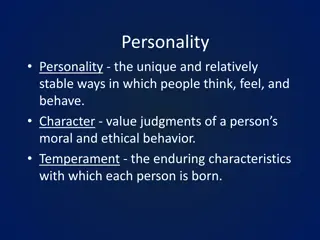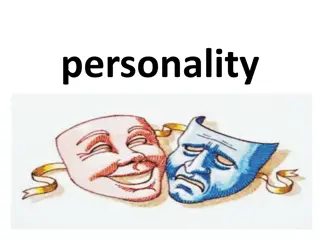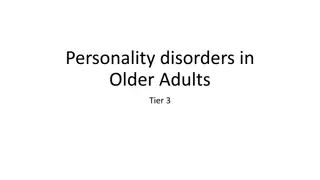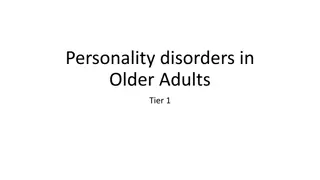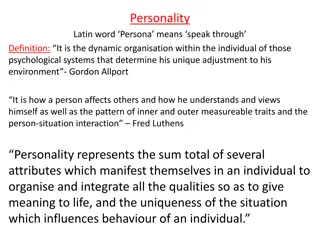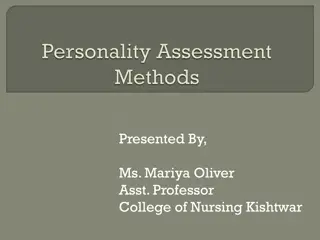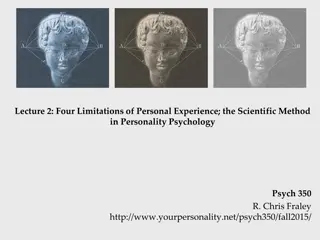
Understanding Engineered Personality Systems and Dissociative Programming
Explore the intricacies of engineered personality systems and deliberate dissociative programming used by organized abuser groups to create fragmented identities. Learn how training programs and sections within the brain play a role in conditioning individuals through trauma and conditioning sequences. Uncover the 13 foundational blocks of parts as described by Stella Katz in Kaballah training, which involve elements like sex, spirit, language, pain, and more.
Download Presentation

Please find below an Image/Link to download the presentation.
The content on the website is provided AS IS for your information and personal use only. It may not be sold, licensed, or shared on other websites without obtaining consent from the author. If you encounter any issues during the download, it is possible that the publisher has removed the file from their server.
You are allowed to download the files provided on this website for personal or commercial use, subject to the condition that they are used lawfully. All files are the property of their respective owners.
The content on the website is provided AS IS for your information and personal use only. It may not be sold, licensed, or shared on other websites without obtaining consent from the author.
E N D
Presentation Transcript
Engineered Personality Systems Alison Miller, Ph.D., Psychologist (Retired)
Abusers Deliberate Use of Dissociation Organized abuser groups are aware that severe childhood trauma, built upon a base of disorganized attachment, can split a person s brain into dissociated parts. Severe infant and childhood trauma separates brain circuits with separate sense of self, each of which can be given a task or job in which it is trained through harsh conditioning. This is achieved through prolonged and repetitive torture of the victim, beginning in infancy. It is still one person, one brain. One badly hurt person, and a brain that had to adapt to living with hidden torture. Understanding the kinds of training programs and the jobs parts have been assigned enables a therapist, to help the parts work together to resolve the trauma and create a cooperative and gradually integrating personality system.
Training or Programming Programs (the term used by some perpetrator groups) are behavioral conditioning sequences used to condition individuals or parts of dissociative people to behave in certain ways without the front person knowing why. Most programmed behavior results from terror. Drugs, extreme arousal, pain, torture, and life-threatening situations are used, beginning in infancy or even pre-natally. The memory of each conditioning sequence is split between several parts of the person, so that the parts who have to produce the programmed behavior are amnestic for the conditioning sequence. The programming has the effect of a post-hypnotic suggestion. Certain parts are instructed to implement the programs in response to specific conditioned stimuli.
Sections Within the Brain Early in the child victim s life, the group creates the different sections of inner people, beginning with one part (alter) from whom the rest of the parts of a particular type are to be split: e.g. sex slaves, pain holders, perpetrators, animals, witches, couriers, reporters, spies, assassins. Each initial insider is given a set of cues , each of which will bring him or her out to do his or her job. A cue may be visual, like a playing card or a picture or a raised eyebrow, or auditory like a song hummed or a series of knocks, or tactile, like a particular touch. Many different insiders respond to such cues. Over the years, the personality system is developed, like a tree with branches, until there are many parts of each type. Sections may be assigned specific colors to identify them. Most of the people are not very substantial but may just have one skill or obey one order. When a particular skill combination is needed for a task, the cues for each skill needed are shown, resulting in a temporary person who has that combination of abilities or traits. The temporary part may have a hyphenated name like Mary-Louise, because it combines Mary and Louise.
13 Foundational Blocks of Parts (Stella Katz, Kaballah Training) 8. Sex 1. Spirit 9. Demons 2. Language 10. Animal 3. Guards 11. Re-activators 4. Touch (harming own or other s body) 12. Doubles (backups) 5. Magik 13. Garbage bin 6. Sacrifice (killing, cutting, dissection) These are located in the chakras through harm to those points. 7. Pain
Insiders Jobs 7 Most insiders have specialized jobs in which they have been trained. Some jobs are always to be done; other jobs are to be done in response to certain types of events in the inner or outer world. Some jobs involve action in the outside world (e.g. reporting to family members, opening doors, answering phones, coming when called, conveying messages, sexual slavery, assassination, ritual sacrifice, using Satanic languages). Other jobs are done in the inside world (e.g. keeping records, watching the person s behavior, distributing programs, giving orders, punishing noncompliant parts, turning programs on, frightening child parts, reactivating programs). Most insiders engage in forced labor, doing jobs out of fear of themselves or others being killed or tortured. Child parts (probably all those with jobs are children) memorize and respond to deliberately placed touch, sound or sight triggers or signals for accessing specific insiders or giving instructions.
Backups (Doubles) All insiders with jobs have several backups, others who will take over their jobs if an original insider decides not to do its job. When negotiating with insiders to quit their jobs, be sure to include the backups.
Where Inside People (Insiders) Live, in Deliberately Structured Personality Systems 9 Each system has sections, each section built from one original split-off infant. Different sectors contain different kinds of insiders, some groups hidden. There may be a primary structure in which the group-created parts are located, e.g. a pyramid, or a spider web. There is an original design for each personality system, with one major structure, or a series of related structures. There may be control rooms with control panels, wiring and switches, in which trained parts turn programs on and off in response to cues or dates. Different programmers over time may create new sections and place them somewhere in the system, often hidden from insiders created by the original trainers. There may be a complicated inner world with deliberately encouraged internalization of external places. In most cases the personality system is deliberately structured into layers or levels as well as sections, and everyone has to stay in their place. With ritual abuse, there s often a layer of parts created each year on the birthday.
How the Inner World is Created A very young child is given building toys and a diagram of the structure he is to build. When a part succeeds in completing this task, he becomes the primary builder part. After the model of the structure is built, the child (not necessarily the same part) is told to put it inside his or her mind. A young child is taken to specific places which the perpetrator group wants him or her to replicate internally. Theatres are used for special effects and stage settings. Movies, virtual reality and video games are used to help the child visualize the places the perpetrator group wants in the child s head. Survivors from earlier generations may have been shown pictures in books.
Builders These are young (age 3 to 6) children who were taught to build structures with building toys, structures that were then internalized and used to house the various insiders. They may envision themselves as adults with skills in building houses or more complex structures. They can use their skills to help redesign the inner world or create better structures than the ones provided by the abuser group.
Basic Programming for All Parts Loyalty and obedience Silence/don t talk (about the abuse or the abusers) Don t love anyone (or they will die, or your energy will harm them) Accept only the friends or partners the group sends you Don t trust outsiders
Front People Front people are the parts of the person that handle everyday life ( apparently normal personalities. ) They are trained not to be aware of or remember the abuse, even if it is ongoing. Survivors usually have a series of front people from different ages. When one finds the job too stressful, s/he may be replaced. Different ones have different skills but they seem to share recent memory (not of trauma). Several front people may share the job at any particular time, and what the person remembers or how s/he behaves depends on which ones are present. Often the front person is a shell which contains different combinations of parts at different times. Or it may be a stage upon which different groups of players act out their roles. There is usually a strong barrier against the front people knowing anything about the other inside parts or communicating with them. A huge crevasse, or a wall of fire. Communication through the barrier is strictly forbidden.
Programming for Front People Appear normal Keep emotions under control Don t hear voices Don t communicate internally Don t remember the abuse
Types of Denial Programming Forget (abuse memories) Don t remember No internal communication; only front people come out Don t believe your own memories Remember impossible things (cover memories)
Moderators and Modulators These parts operate behind the scenes (behind the front people in everyday life, including therapy sessions) to smooth things out. A Moderator I met had the job of making the person s speech sound like an adult of the age she was, regardless of the age of the part who was communicating, so that a listener would not recognize the presence of a child part. A Modulator I met smoothed things out in other ways, making sure that communications to other people were all reviewed and made acceptable to the listener, while not revealing protected or sensitive information.
Programs You See in the Therapy Room Don t look at therapist Don t trust therapists, doctors, law enforcement, fear them Therapy interference (distract, seduce, overload and burn out the therapist) Kill or harm someone who is kind to you Lie to therapist See your handler in the room Run from helpers Sleep (usual use: other parts sleep while one goes out to a ritual) Remember (that you are a perpetrator; that therapists are abusers, etc.) Itching (as distraction and reminder; each itch carries a message) Remember impossible cover memories Don t remember faces Paranoia ( We can hear you )
Distractors and Confusers Many types: Disrupt therapy sessions by being cute, mute, or itchy Cause client to fall asleep in session Cause client to forget what just happened or what she just remembered Could divert client s attention to other things when getting close to important information. Especially current events causing anxiety. There may be Chameleon parts who pretend to be other specific parts
Internal Hierarchies 21 In most mind-controlled or cult personality systems, parts are set up in one or more hierarchies. Hierarchies often result from progressive splits with a new layer built each year (e.g. Satan 1, Satan 2, Satan 9). Each layer will have one of each important alter type, split from the previous one. The last-made layer is in charge. A survivor may have different hierarchies with different bosses, created by different perpetrator groups. Often these clash. The bosses at various levels issue threats to those under them who disobey the rules. The enforcers administer punishments for disobedience, such as flashbacks or self-harm or pain (from memories).
Bosses (Higher-Ups) These higher-ups may have impressive names and titles. One Nazi-created system, for example, had a series of Hitlers, with the one at the top being the real Hitler. A Satanic system had a series of Satans, with various adjectives attached, the first few layers numbered Satan 1 through 9, and then the Most High Satan. Many bosses may have the names of actual perpetrators (trainers or programmers) who were in the abused child s life. Just because an insider is named Hitler or Satan or the name of someone who abused the child doe not mean that part wants to be like that person. The higher-up parts, who rarely if ever come out in everyday life, may not know about how the survivor s life circumstances have changed. To really change things, you (the therapist) need to work your way up to the top of the hierarchy and talk to those in charge. Start with the punishers, then those who give them orders.
Enforcers, Soldiers and Guards In the internal world, enforcers administer punishments, which are usually pain from memories, when the person has broken the rules of the perpetrators. They are obeying the orders of higher-ups. If the person is considering breaking the rules (such as telling a therapist something), there are parts who issue threats regarding what will happen (externally as well as internally) if the rules are violated. In some systems, there has been systematic training of child soldiers, who then become soldier parts. While they have internal jobs, they might be called on at some time to become actual fighters in the external world. Some are trained to use weapons, including guns. They are highly trained in loyalty, much like real adult soldiers. They may believe they have killed other soldiers, as this has been simulated.
Punishment Programs Various kinds of pain (controlled bodily flashbacks from memories) Seeing horrendous scenes (controlled visual flashbacks) Self-harm (specific: cut, burn or scratch) Eating disorders (also used to hide pregnancies) Internal homicide Suicide Internal disasters (the structures in the internal world crash, burn tidal wave, flood, fire, earthquake, etc.)
Steve Frankels Warsaw Ghetto Analogy 25 A. Internal managers who cooperated with the Nazis: The co-opted government (Judenraten), the ghetto police (enforce rules: don t leave, don t call for help, don t smuggle anything in or out), loyalists and deniers (spies for the Nazis, those who denied the severity of Nazi intentions) B. Victims most of the inhabitants, fearful and traumatized, engaged in forced labour, no contacts outside the ghetto. C. Opposition, tried to create change: social service providers and nurturers, the underground or resistance, the archivists, observers who told the outside D. Independents and anarchists (observers, thieves, food smugglers)
Record Keepers File keepers, librarians and record keepers are some of the job titles given to these parts. Records they may have: A copy of the victim s black book about his or her training experiences The memories of training experiences A record of all traumatic memories A record of all insiders, their locations and their jobs Getting them to work with you can speed up therapy and make things intelligible, as you can access their knowledge. These parts may have memorized entire conversations word for word in order to be able to repeat them back.
Internal Programmers or Switch Controllers Switch controllers (also known as internal programmers) turn programs on and off by internal switches and buttons which have specific effects, like putting parts to sleep or making them suicidal or creating hallucinations. They are mid-age children who were placed in physical locations with these switches and control boards where they were trained to respond to cues and do their jobs. They may never have seen the actual outside world, other than these places. They usually don t know what the switches they control do, although they may know the names of the programs they are turning on and off. They only know that they must do their jobs immediately when given the signal to do so. Signals to them may be external or internal (e.g. some other part pushing a button connected to a wire)
Gatekeepers Gatekeepers hold in or release inside people or memories. They act on instructions but have some latitude to make decisions if they are not being told directly what to do. Generally a gatekeeper does not allow most trained parts out into the body unless given a signal such as a touch on the left shoulder combined with the name of the part who is called for. Kaballah groups create a single Gatekeeper who is the first split after birth, is never again abused, and grows up with the body and observes everything. (see Stella Katz s chapter in Healing the Unimaginable)
Pain Holders These are usually very young infants. Some hold physical pain. Particular ones may hold pain in different body locations. This pain can be drawn upon by the punisher parts, who send it to the front people or others who were disobedient to the abusers. Certain parts (e.g. soldiers, sexual masochists) are not supposed to feel pain, so pain holders (who may be sub-parts within the soldiers) hold the pain for them. Some are specialized for holding emotional pain. Particular ones may hold despair, sadness, anger, frustration, anxiety, etc. These feelings are generally held in and not experienced by the front people, but they may be drawn upon to punish, just like the physical pain. Anger may be given to perpetrator parts when the group needs it; despair to front people to motivate a suicide attempt. Some hold empathic pain for other people who are suffering or being hurt. When this pain is kept separate, perpetrator parts can do their jobs without feeling the pain of those they hurt. To help perpetrator parts stop doing these jobs, the healing system can share the empathic pain with them.
Spinners Spinning infants and children on turntables makes them off balance. It also distributes the lesson the child is being taught to the rest of the personality system. Spinning is often used at the end of an abusive episode or programming session to distribute the lesson to other parts. A child part is taught to physically spin round and round, making all other parts of her dizzy while the one doing the spinning does not feel dizzy and keeps her balance. Her job is to do this internally to distribute feelings and impulses through the system. If your client reports a sensation of spinning, it is an indication that a program may be running. Spinner parts (if you ask nicely) can reverse the spin in order to stop a program from working, and can slowly spin something soothing and pleasant through the system to help stabilize things.
Types of Access Programming Come when Called Return: Respond to hand signals, gestures, facial movements, touch triggers Return for rewards (sex and drugs) Return to save someone Answer phone Return to avoid punishment of self or others Open door Leave door unlocked Return on scheduled ritual dates Report Go outside Left shoulder touch along with name brings out desired part Phone mother or other apparently innocent family member Don t leave town Report the person s disclosures Report relocations Report on other people
Watchers and Reporters Watchers and reporters observe the survivor s behavior and thoughts and report disobedience to internal or external bosses. They may be trained to report every word of a conversation to the perpetrators, especially therapy sessions, and to always tell the truth to perpetrators, who they believe already know everything. They can work towards healing by reporting instead to the therapist or to inner helpers about what is going on in the person s life. Sometimes they can learn to lie to abusers so that therapy sessions sound innocuous when the sessions are actually destroying the programming. This begins with helping them realize that abusers don t know everything. Or they can be made to forget most of a therapy session (by those who hold the Forget programs) so that they report only the innocuous parts of the session.
Programs to Get Survivor into Hospital Hallucinate Rapid switch Flood feelings Only child alters come out Depression Hear threatening voices Paranoia Scramble Anorexia Behave like an animal Believe you re a famous person (have copy alters of such people) Some of these are also to discredit a survivor who remembers too much.
Programs for Use in Rituals Training not to sleep (preparation for ritual) Training not to eat (preparation for ritual) Training to hold urine and feces Training to keep still and silent, training to make the usual front person sleep Training not to run Training not to feel pain Training to use a knife for killing or dissection Training to kill Training in occult languages Training to dance like a snake (Serpents cult)
Types of Sexual Parts 35 Breeders (who give birth to infants for sacrifice or sale), and may be mothers to unregistered children for years Nymphomaniacs Masochists Necrophiliacs Sexual perpetrators including killers Seducers (for example, of therapists) Mixing parts is important here. Pain holder parts are paired with the masochist and perpetrator parts so they don't feel the pain they experience or inflict. Frequently the victim is trained that he or she cannot experience orgasm unless in a violent situation, either hurting someone or being hurt by someone. Killers are trained to experience orgasm when someone is killed. Drugs enhance this. Kids are trained by being masturbated while watching filmed then actual violence. Perpetrator groups thus produce the customers for sadomasochistic sex which they sell.
Demons Demons and devils are usually small child parts, split off at ages 3 to 5, costumed and taught to make demon sounds by larger (adult) demon impersonators. They may have the names of demons found in ancient books. They have been taught no one will ever want them. They may have been taught they will harm anyone they speak with. Do not try to banish them or they will retaliate by destabilizing the client. Satans, gods or other supposedly demonic alters may have a hierarchy and may be in charge of the system if it s one of religious (ritual) abuse.
Animals Parts who believe themselves to be animals (or chimeras, half-animals and half-human) are used for doing what those animals do. Horses run fast, cats sneak out at night, dogs beg and come when called, snakes do dances at rituals. These parts are trained by being costumed, put in cages with animals, told they are that kind of animal, and only fed when they behave like that animal. One system s recorder parts believed themselves to be orcas, and were actually trained in a tank with orcas. They believed they couldn t speak.
Language Speakers For Satanic or Luciferian cults May write in mirror language or speak in backwards English Can speak fluent Enochian or other occult languages May also have languages from childhood when family has moved Some may not know English or the language of the country the survivor lives in Some also know English and can be used as internal translators
Knife Wielders Stella Katz (in Healing the Unimaginable) writes of a category of insider called the Touch block. These are their duties. Performing sacrifices at rituals (with a knife) Dissection of bodies (usually for consumption) Self-harm, usually as punishment for disobedience (the part receiving the pain feels it; the part doing the cutting or burning does not). Some other part may be making the cutter do it. Those designated to be assassins in the real world have a combination of parts to perform the assassinations one who is trained in the particular type of violence, others to handle different parts of what leads up to the event and what comes afterwards.
Witches, Psychics, Spiritual Leaders Sophisticated perpetrator groups such as military agencies assess children for known ESP abilities (telepathy, remote viewing capability, etc.) Those found to have such abilities are trained to use them on behalf of the group. Remote viewing experiments were done by military agencies. Ritually abusive groups create parts known as witches whose abilities are used to curse people. These parts may only be used if they show some psychic skill. These parts believe they can kill with their minds, as this has been simulated (they were told to kill someone, then this person fell to the ground.) Parts called witches can disobey and curse the wrong person, and the group will not know. Some parts, whether or not they are trained, can use their psychic abilities to see what is inside other people, and whom they can trust. Often floaters do this.
Ghosts and Aliens and Spirits and Gods Ghosts and other incorporeal entities are insider parts who were led to believe they do not belong to the body. Anaesthetic drugs make non-human parts unable to feel anything in the body so they believe they do not belong to it. Sometimes they represent suicide programs (internal homicide) kill this traitor s body. Sometimes they hold knowledge which they supposedly can t disclose because they can t speak. Sometimes they check up on and discipline the system leaders. You won t get to these for a long time; they are hidden and may be outside the system structure. Prove to them that they are in the body.
Re-Activators of Programs Perpetrator groups need to have a way to re-activate any programs which have been de-activated through a survivor s healing process. They create reactivator parts for this purpose. Some of these insiders are instructed to take a particular part of a training memory, such as a sound or a word something crucial that will let the perpetrators know what program was being created. These parts are hidden, and they keep this piece of memory separate, so that if the survivor puts the training memory together, the piece is not included. Reactivator parts also let the perpetrators know that the memory has been worked on; by giving the perpetrator group their piece of memory, the group can know what training of theirs was disabled, and can repeat it. Other insiders are trained to put their piece on an internal turntable which will re- grow the program. I don t know just how this works, but it reactivates the program. To destroy a program permanently, it is necessary to put together all training memories for this program, and include every single part of those memories, especially the pieces held by the reactivators.
Paired Programs Programs are often taught in pairs of opposites, in which only one pole is activated at a time. Sleep/insomnia Eat/don t eat Tell (report)/Don t tell Run/don t run Die/don t die
Recognizing Programming You can recognize specific programs by their effects. The part out in the world is not the one in control of programmed behavior. It won t do any good to ask that part about it, though they can ask inside to get information from other parts. If you suspect that a program is operating, check on whether the survivor feels dizzy, as though something is spinning inside her or his head, as internal spinning is the way in which a program is distributed to parts. Perpetrator group members in churches or similar groups take leadership positions and send messages through hand signals or facial signals. Zoom gives them a helpful platform. I realized that one client was a survivor by watching her do a trigger for Forget on her own face. If you know hand signals or facial signals, you might observe parts trying to send messages to you via these.
Turning Programs On or Off Programs are activated by remembering the abuse, talking about the abuse, everyday accidental triggers (words, touches, sounds, sights), deliberate triggers, events and dates. Many programs have off triggers as well as on triggers. If you know the triggers, you can turn a program off, but this should only be used in an emergency because it might make your client suspect you are a perpetrator. Programs turned off can always be turned on again. Sometimes the same trigger will activate or turn off different programs in different survivors. You can only permanently deactivate a program by putting together the memories which created the program, with all involved parts.
Attaching Programs to places or events Perpetrator groups can attach programs to particular events or places, e.g. a program may be activated by entering the therapist s office. Programs can be attached to one another (e.g. if a therapist attempts to undo the suicide program it activates the attack therapist program.) If current contact with perpetrators is suspected, you might discuss such linkages by telephone with internal programmers before an appointment. Some parts of the client may be able to make a wiring diagram of how the programs are attached to one another.
Parts the Abusers Dont Like 47 and don t deliberately create Garbage Kids (discarded for disobedience) Floaters (hidden observers) Inner self-helpers, caregivers, nurturers (usually self-created) In the ghetto, these are Group C: the resistance and the archivists and the social service providers. All these can be helpful in recovery. Find the garbage kids, as they have the strength to resist orders from the perpetrators. Enrol them in healing.
More About Floaters In a traumatic babyhood and infancy, floaters are frequently split off, sometimes many during one event. I ve heard repeatedly of floaters seeing what is going on behind the scenes, things that can t be seen from the body s viewpoint. Besides the floater parts who are simply observers of events, there can be many floaters who hold emotions. To fully resolve infant memories, the floaters must be invited back into the body, and to share their perceptions and emotions with the rest of the system. Floaters must be included for full integration. I have heard of floaters who can act in the outside world even though invisible, for example break objects to distract abusers (like poltergeists ).
Making Changes All parts, no matter what they have been told, are human, and most are children. Relate to them with this in mind. In there is a human soul, longing for connection and healing. No one inside is a bad guy ; those who enforce perpetrators rules are working for the safety of the system. As parts with jobs identify themselves and join the internal coalition for healing, they can be given new jobs which use the skills they developed for the original perpetrator-assigned jobs. Do not fire internal leaders assigned by the perpetrators until and unless an alternative internal government has been developed. It works better to work with the assigned leaders, who can give orders to those under them, while helping them move towards a more democratic system.

![❤[PDF]⚡ Escaping from Eden: Does Genesis Teach that the Human Race was Created](/thumb/21697/pdf-escaping-from-eden-does-genesis-teach-that-the-human-race-was-created.jpg)
